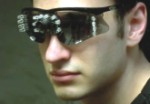|
Sci-tech
The
Teenager-only PC
This isn't your typical, humdrum, slate-coloured computer.
Not only is the PC known as the hip-e almost all white but
its screen and keyboard are framed in fuzzy pink fur. Or
a leopard skin design. Or a graffiti-theme pattern. Sure,
it's outlandish, but you won't see the hip-e in an office
cubicle. The creators of the $1,699 hip-e claim this is
the first PC specifically for teenagers. Last year, Digital
Lifestyles' CEO Kent Savage got his son Cameron, 16, and
seven of his friends together and polled them about how
they interacted with computers and the Internet. Cameron
and his friends were asked to draw up designs for their
ideal PC. Two weeks later, the company came back with 20
product concepts and in a five-hour session, the teens honed
in on one. The computer has a 120-gigabyte hard drive --
perfect for storing a huge digital music library -- plus
Wi-Fi accessibility, a TV tuner and connections for video
game consoles. Speakers attached to the bottom of the hip-e's
display stand can be removed and turned into a portable
"beatbox." Retooled to speak to teens in everyday
terms, users can click on "paper" to launch Microsoft
Word, "create a presentation" to launch PowerPoint,
or "burn CD" to open a CD-copying program. The
17-inch desktop display -- which boots up to screaming black
and white swirls and squiggles against a lime-green backdrop
-- has a "hangout tuner," an on-screen dial that
lets users jump to categories of desktop applications: music,
movies, games, photos, news, communications, shopping and
homework.
Implanted
Power Source
The
"biothermal battery" under development by Biophan
Technologies of West Henrietta, will generate electricity
using arrays of thousands of thermoelectric generators built
into an implantable chip. These generators exploit the well-known
thermocouple effect, in which a small voltage is generated
when two of the junctions between two dissimilar materials
are kept at different temperatures. But Biophan is going
to need a large number of thermocouples to generate the
power it needs. In the past, stacks of perhaps tens of thermocouples
have been used in some temperature sensors but no-one has
tried to build thousands of them into one device, as Biophan
will need to. The company's chief executive Michael Wiener
is confident his engineers can build thermocouples just
tens of micrometres across to do the job, using unspecified
microchip manufacturing technologies. Today's pacemaker
batteries last for more than a decade before they need replacing.
Biophan says the device it is aiming for will be able extend
this to three decades by continuously trickle-charging pacemaker
batteries. It might even be able to operate some low power
pacemakers directly. Tim Bowker of the British Heart Foundation
welcomes the prospect of such a technology. Anything that
means patients need fewer surgical procedures, which are
stressful and carry the risk of infection, will be more
than welcome, he says.
Video
Games Get
Emotional
 Penn
State researchers have developed an automatic lighting system
that can speed up the development of interactive stories
and videogames, thereby enhancing players' experiences,
by adding more tension and emotion to a scene. Expressive
Lighting Engine (ELE), is an intelligent system that allows
game developers to use lighting to direct attention to particular
objects or characters, create mood and provide visual depth.
As well as automatically placing lights to illumine a scene,
ELE also selects their positions, colours and angles. "Lighting
in game engines is static and restrictive, and it doesn't
change with interaction. ELE draws on cinematic and theatric
lighting design theory and enables game designers to fully
use lighting's subtle but powerful effects," said Magy
Seif El-Nasr, an assistant professor in the Penn State School
of Information Sciences and Technology. ELE also helps game
designers, responds very quickly as compared to current
lighting design, which is time-consuming, often requiring
weeks of tweaking. Because the system is dynamic, it can
also be used to change the level of difficulty in a game.
For instance, characters can be lit up to be obvious for
beginners, whereas for more experienced players the lighting
could include more shadows. "ELE allows artists to
control its behaviour at a high level or a low level. Additionally,
ELE supplies artists with a language to write rules for
specific lighting changes or set up," she added. Penn
State researchers have developed an automatic lighting system
that can speed up the development of interactive stories
and videogames, thereby enhancing players' experiences,
by adding more tension and emotion to a scene. Expressive
Lighting Engine (ELE), is an intelligent system that allows
game developers to use lighting to direct attention to particular
objects or characters, create mood and provide visual depth.
As well as automatically placing lights to illumine a scene,
ELE also selects their positions, colours and angles. "Lighting
in game engines is static and restrictive, and it doesn't
change with interaction. ELE draws on cinematic and theatric
lighting design theory and enables game designers to fully
use lighting's subtle but powerful effects," said Magy
Seif El-Nasr, an assistant professor in the Penn State School
of Information Sciences and Technology. ELE also helps game
designers, responds very quickly as compared to current
lighting design, which is time-consuming, often requiring
weeks of tweaking. Because the system is dynamic, it can
also be used to change the level of difficulty in a game.
For instance, characters can be lit up to be obvious for
beginners, whereas for more experienced players the lighting
could include more shadows. "ELE allows artists to
control its behaviour at a high level or a low level. Additionally,
ELE supplies artists with a language to write rules for
specific lighting changes or set up," she added.
Smart
Glasses
 A
pair of sunglasses that can detect when someone is making
eye contact with the wearer has been developed by Canadian
researchers. Besides being useful in singles bars, its inventors
say the system could play a key role in video blogging,
a hi-tech form of diary keeping. Video bloggers record their
lives from the point of view of a first person video narrative.
"I think this is something that we will see over the
next few years," says Roel Vertegaal, co-creator of
the glasses at Queen's University's Human Media Lab, in
Ontario, Canada. The main problem is the tedious process
of editing out the dull bits where nothing much happens,
says Vertegaal. So the glasses allow a video blogger to
automatically detect and record interactions and conversations
with other people. The glasses consist of a normal pair
of shades with a small CCD camera attached on the bridge
between the lenses. This is connected to a handheld computer,
worn at the hip, which handles the image processing. Light
emitting diodes, or LEDs, positioned around the lenses emit
infrared light creating a kind of "red eye" effect
in the eyes of anyone facing the camera. This is used to
locate any eyes in the scene. The system then looks for
the glint created by the light reflecting off the cornea
of the eye to determine if that person is looking directly
at the wearer's eyes, or elsewhere. If the glint appears
right in the centre of the pupil then it means the person
is making eye contact. Vertegaal admits that, given the
current appearance of the glasses it is likely that everyone
will be looking at the wearer. But he says that is part
of the point - to attract people to interact. But the glasses
have failed to impress one video blogger contacted by New
Scientist, TV producer Steve Garfield. You would look like
a crazy person and still end up having to do substantial
editing of your footage, he says. "I would never use
anything like this." A
pair of sunglasses that can detect when someone is making
eye contact with the wearer has been developed by Canadian
researchers. Besides being useful in singles bars, its inventors
say the system could play a key role in video blogging,
a hi-tech form of diary keeping. Video bloggers record their
lives from the point of view of a first person video narrative.
"I think this is something that we will see over the
next few years," says Roel Vertegaal, co-creator of
the glasses at Queen's University's Human Media Lab, in
Ontario, Canada. The main problem is the tedious process
of editing out the dull bits where nothing much happens,
says Vertegaal. So the glasses allow a video blogger to
automatically detect and record interactions and conversations
with other people. The glasses consist of a normal pair
of shades with a small CCD camera attached on the bridge
between the lenses. This is connected to a handheld computer,
worn at the hip, which handles the image processing. Light
emitting diodes, or LEDs, positioned around the lenses emit
infrared light creating a kind of "red eye" effect
in the eyes of anyone facing the camera. This is used to
locate any eyes in the scene. The system then looks for
the glint created by the light reflecting off the cornea
of the eye to determine if that person is looking directly
at the wearer's eyes, or elsewhere. If the glint appears
right in the centre of the pupil then it means the person
is making eye contact. Vertegaal admits that, given the
current appearance of the glasses it is likely that everyone
will be looking at the wearer. But he says that is part
of the point - to attract people to interact. But the glasses
have failed to impress one video blogger contacted by New
Scientist, TV producer Steve Garfield. You would look like
a crazy person and still end up having to do substantial
editing of your footage, he says. "I would never use
anything like this."
Source:
Webindia123.com / Newscientist.com / Google
Copyright
(R) thedailystar.net 2004
|
